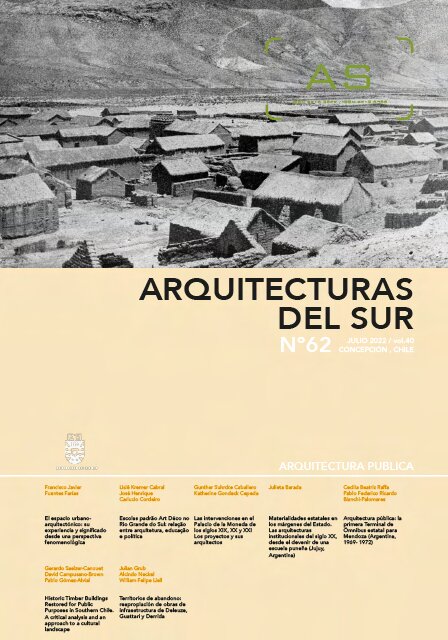PUBLIC ARCHITECTURE: THE ACTION OF THE STATE
DOI:
https://doi.org/10.22320/07196466.2022.40.062.00Keywords:
-Abstract
In Chile and Latin America, the State has built the city. Thus, from buildings and public spaces, institutional, school, housing, hospital, industrial, and transportation architectures, to the most diverse spheres, the State’s action in the production of public architecture is undeniable. At different times, this fact has been more or less valued or recognized. For example, during the presidency of José Manuel Balmaceda (1886-1891), his administration undertook numerous public works that sought to spread modernization throughout the country through buildings and infrastructure. Likewise, during the 1940s, with the boost of the Popular Front governments, there was a sustained institutionalization action that resulted in the construction of numerous buildings, that spread the benefits of modern architecture for public architecture and working-class housing. With the application of a capitalist economic-social model, which privileges market fluctuations, from the 1970s to the present, the private sector has been favored, so that the State’s action in the production of the city has been curtailed and, on many occasions, muted or vilified.
Downloads
References
-
Downloads
Published
How to Cite
Issue
Section
License
Copyright (c) 2022 Pablo Ramón Fuentes-Hernández, Gonzalo Andrés Cerda-Brintrup

This work is licensed under a Creative Commons Attribution-ShareAlike 4.0 International License.
The content of the articles published in each issue of Arquitecturas del Sur is the sole responsibility of the authors and does not necessarily represent the opinion of University of the Bío-Bío.
The authors will maintain their copyright; however, they will guarantee the journal the right to first publication and dissemination of their work. The publication of the article in Arquitecturas del Sur will be subject to the Creative Commons International license (CC BY-SA) that allows others to adapt: remix, transform and build on the material for any purpose, even commercially; share: copy and redistribute the material in any medium or format, as long as the authorship and first publication in this journal are acknowledged by citing them correctly, and their new contributions are under a license with the same terms.














 Programa de Información Científica/Concurso Fondos de Publicación de Revistas Científicas 2018/ Proyecto Mejoramiento de Visibilidad de Revistas UBB (Código:FP180007)
Programa de Información Científica/Concurso Fondos de Publicación de Revistas Científicas 2018/ Proyecto Mejoramiento de Visibilidad de Revistas UBB (Código:FP180007) 
